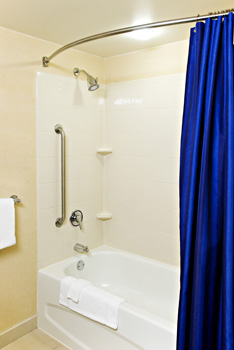
- Ensure proper lighting is used, this is especially important at night when bathroom visitors are groggy or not wearing their glasses. A reliable night light can help avoid stumbles, bumps and bruises.
- Install grab bars to provide stability and can minimize the impact of a fall. Grab bars should be installed in the shower, bath and near the toilet. You can choose between permanently installed bars or removable clamp-on models, but regardless of which type you choose, make sure you never use toilet paper holders, wall mounted sinks or towel racks to support your weight.
- Use non-slip flooring in the tub and shower or if new flooring isn’t in the budget, non-slip bath mats with rubber suction-grip or adhesive strips are also an effective way to prevent slipping. Also look for bath mats with rubber backing to place outside of the tub and shower.
- Turn down the heat on your water to avoid accidental scalding. Keep the water heater set at no more than 120 degrees to avoid water scalding accidents. If you want some extra reassurance, look for ADA (Americans with Disabilities Act) Compliant faucet that has a hot water safety stop.
The modifications below require a more significant investment, but have a great impact on the ease of use in your bathroom:
- Replace your bathtub with a walk-in tub or walk-in shower. Tubs can be difficult for seniors to use because you have to step over the tub wall to get in, compounded with slippery surfaces and senior balance difficulties, and you have a significant fall risk. Walk-in tubs have a door in the wall, eliminating the need to step over a raised wall. If no one in your house bathes regularly, consider replacing your tub with a walk-in shower with a seat to reduce exertion.
- Get a taller toilet. Standard height toilets can be a long way down for seniors, particularly with knee, back or hip problems. Chair height toilets (as they are commons called) senior-friendly because they are higher up, which allow seniors to more easily lower and raise their body weight.
For help implementing any of these bathroom modifications or if you’d like to brainstorm other ways to make bathrooms for convenient for seniors, contact us today.
